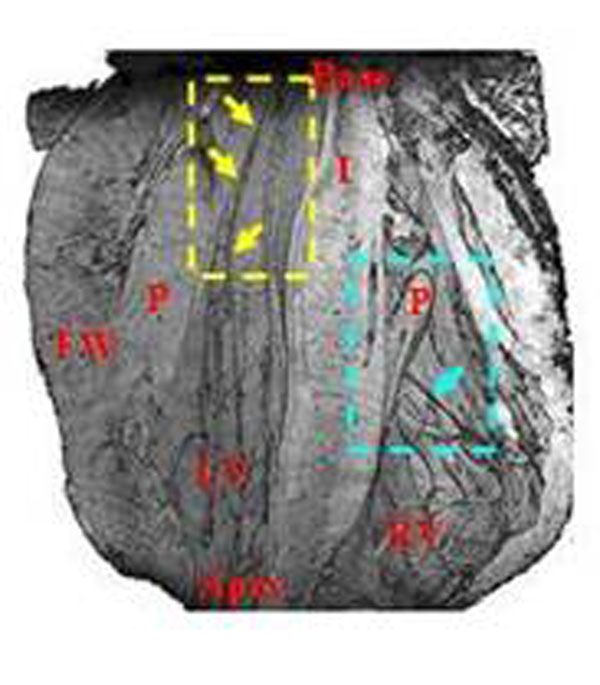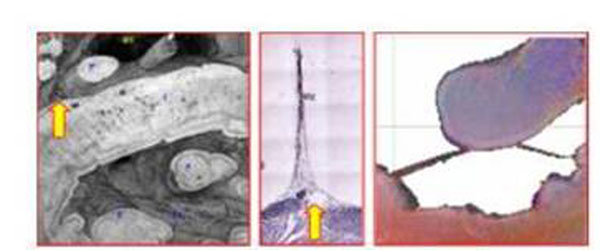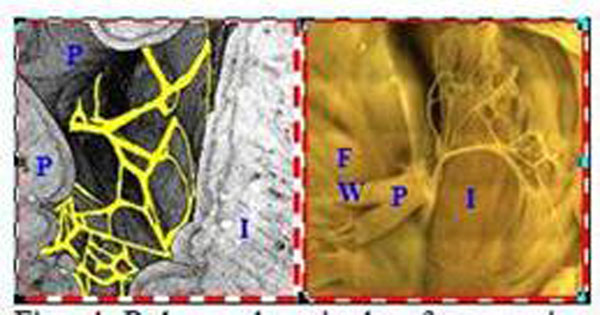Background
The impulse-conducting system that coordinates the cardiac cycle requires a well-orchestrated interplay of its multiple heterogeneous components for synchronous and reliable contractions [1]. Thus, detailed insight into the anatomy of the conduction system would be of great significance to understand the cardiac performance arising from electro-mechanical activity [2,3]. To date, the techniques most commonly used to study the conduction system are invasive, and use intrinsically destructive procedures. MR imaging has previously used to visualize free-running Purkinje fibers[3,4], but not those in the myocardium, and thus only provide a partial account of the conduction system.
Purpose
In this study, we aim to provide non-invasive MR data suitable to describe the complete conduction system and anatomical features in isolated rabbit hearts, as a precursor to developing a mathematical model of depolarization in the heart.
Materials and method
Hearts (n = 3) of New Zealand White male rabbits (2-4 kg) were isolated and fixed in situ according to the approved animal protocol.
MRI
MR experiments were performed on a 17.6 T / 89 mm vertical wide-bore magnet (Bruker Instruments, Billerica, MA). Three dimensional MR microscopy data were collected using a fast gradient pulse sequence, achieving a voxel resolution of 35 x 35 x 82 μm3. High angular resolution diffusion microscopy (HARDM) was performed with a standard PGSE sequence, achieving an in-plane resolution of 60 μm2 with a slice thickness of 600 μm. The b-value was 1000 s/mm2.
Data analysis
Volume rendering of the 3D MR data sets was performed using ImageJ (ver. 1.31, http://rsbweb.nih.gov/ij/). The tensor processing of HARDM data sets was conducted using fanDTasia™ (©2008, http://www.cise.ufl.edu/~abarmpou/ ).
Results
Figure 1 shows that a volume rendered image from the original 3D MR data made it possible to non-invasively and reproducibly trace the conduction paths in both ventricles, as well as to describe the micro-anatomical features of the heart. Figure 2 demonstrates that fiber tracking from the HARDM data sets represents the conducting pathways from the connecting bundle to the left/right bundles. Since the tendinous fiber-like cords observed in the ventricular cavities contain conducting fibers, called the free-running Purkinje fibers, the primary eigenvector of the cords may correspond to the neurofilament stained Purkinje fibers (Fig. 3). The free-running Purkinje fibers form a reticular polygonal net in the ventricular cavities (Fig. 4). In conclusion, these results demonstrate that MR microscopy is an especially promising modality for complete visualization of the conduction pathways.
Figure 1.
A representative volume rendered 3D MR image to visualize the conduction paths and anatomical features in an isolated heart. A red line and a green arrow in a red box indicate where sectioning occurred and viewer was located to perform the volume rendering. Note that free-running Purkinje fibers in the left ventricular cavities, a left bundle branch (yellow arrows) in ventricular inner wall, a right bundle branch (cyan arrow) and right bundle (right, yellow circle). LV: left ventricular cavity, RV: right ventricular cavity, leaflets of the mitral valve, FW: free wall, P: papillary muscle, I: ventricular interseptum.
Figure 2.
Representative data set from rabbit heart showing fiber tracking of the conduction network from base to midwall (A → D). The conducting network originates behind the non-coronary leaflet at the base (A) and quickly bifurcates (B) into fibers that proceed down the right ventricular subendocardium (shown in blue) and a branch that continues along the septum for a short distance before continuing down the left ventricular subendocardium (C, D) in a fan-like structure (shown in purple). The fan-like structure terminates in free-running Purkinje fibers in the left ventricle. Data from conducting fibers that are more apical has been omitted for clarity.
Figure 3.
Representative images of the free-running Purkinje fibers that show septal attachment from the ventricular cavities. A volume rendered image (left), neurofilament stained image (middle), and the primary eigen vector map (right).
Figure 4.
Polygonal reticular free-running Purkinje fiber network in the LV cavity. A magnified volume rendered MR image (left, yellow is manually segmented with visual inspection) and an optical image of Acetylecholine esterase staining (right, unfolded).
Acknowledgement
Magnetic resonance microscopy was performed using 17.6 T magnet at Advanced Magnetic Resonance Imaging and Spectroscopy center at the McKnight Brain Institute. Funding for this work was provided by the NIH (1R01EB012874), the NSF through the National High Magnetic Field Laboratory, and seed grants (JRF) from the McKnight Brain Institute and the Department of Radiology, UF.






